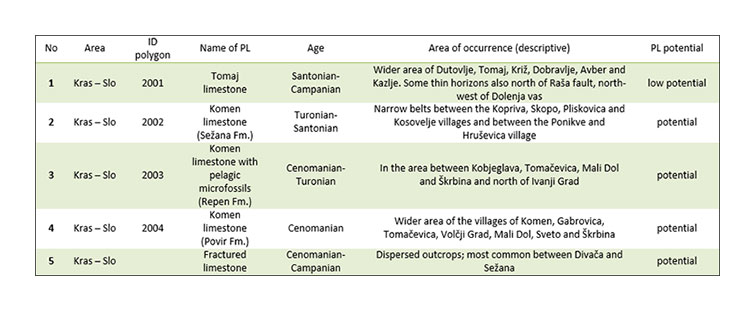Platy limestone – geologic definition and its use as a mineral commodity
Jernej Jež, Uroš Barudžija, Sara Biolchi, Stefano Devoto, Goran Glamuzina, Tvrtko Korbar
A review of the existing geological maps, detailed lithological and stratigraphical analyses and field work in the Kras in Slovenia revealed four main types of platy limestone (PL): Komen limestone from the Povir Formation, Komen Limestone with pelagic microfossils from the Repen Fm., Komen limestone from the Sežana Formation and Tomaj limestone. They can be distinguished due to their litholocical and paleontological characteristics, stratigraphic position, spatial occurrences and age. Three of them are types of so-called Komen limestone that occur at different stratigraphic levels and belong to different geological formations ranging from the Albian to the Campanian (Fig. 2.16).
Komen PL from the Povir Fm. is exposed in the wider area of villages Komen, Gabrovica, Tomačevica, Volčji Grad, Mali Dol, Sveto and Škrbina (Map 2.3 and Tab. 2.3). There it covers an approx. 10km long and 5km wide area. In this area, we also recorded at least seven abandoned quarries of this type of PL. The Komen PL with pelagic microfossils occurs in the central part of the Repen Formation in the area between Kobjeglava, Tomačevica, Mali Dol and Škrbina and north of Ivanji Grad. Abandoned delves are known in the area north-east of Mali Dol. The Komen PL of Sežana Formation is exposed in narrow belts between the Kopriva, Skopo, Pliskovica and Kosovelje villages and between the Ponikve and Hruševica village, where some smaller abandoned delves were recorded. It occurs in different stratigraphic levels of the Sežana Formation. The youngest PL type – Tomaj PL appears within the bedded limestone of Lipica formation in the form of thin and discontinuous lenses and is exposed in a wider area of Dutovlje, Tomaj, Križ, Dobravlje, Avber and Kazlje and also north-west of Dolenja vas (Map 2.3 and Tab. 2.3) (see Appendix 2.2).
In the southern part of the Kras special type of limestone plates were used for roofing
In the southern part of the Kras special type of limestone plates were used for roofing. According to geological definitions, this type of limestone is not classified as platy limestone as its platy appearance is not related to its genesis (processes of deposition and diagenesis) but is of tectonic origin. Dense systems of parallel tectonic fissures/fractures enable excavation of thin, 3-10 cm thick, high-quality limestone plates. This type of limestone plates were excavated in limestone sequences from the Repen and Lipica Formation. In a narrow belt from the Repen Formation abandoned quarries are known to be in the Gabričje and Griža (Tavčar) locality. A quarry of fractured limestone from the Lipica Formation was found near the Filipčje Brdo village.
Expertise Petrologic‐microtectonic analyses of the cleaved limestone on the Kras area (Annex 2.1) on these special types of limestone plates was implemented by a group of experts from the Department of Geology, Faculty of Natural Sciences and Engineering at the University of Ljubljana. With respect to the genesis, expertise suggests the following name for this limestone type: Fractured limestone.











